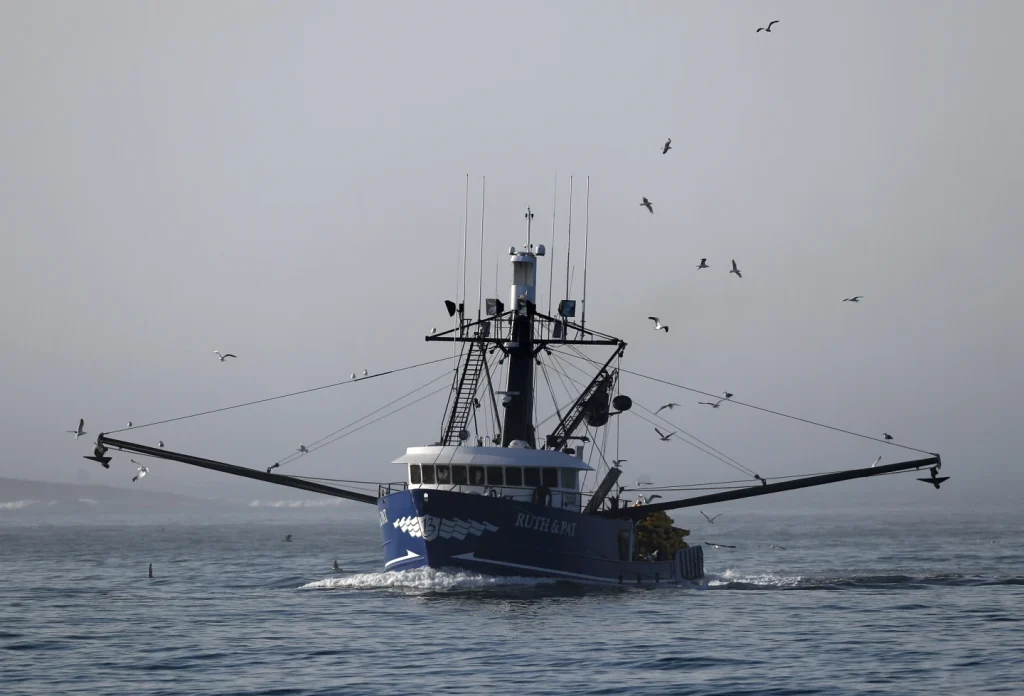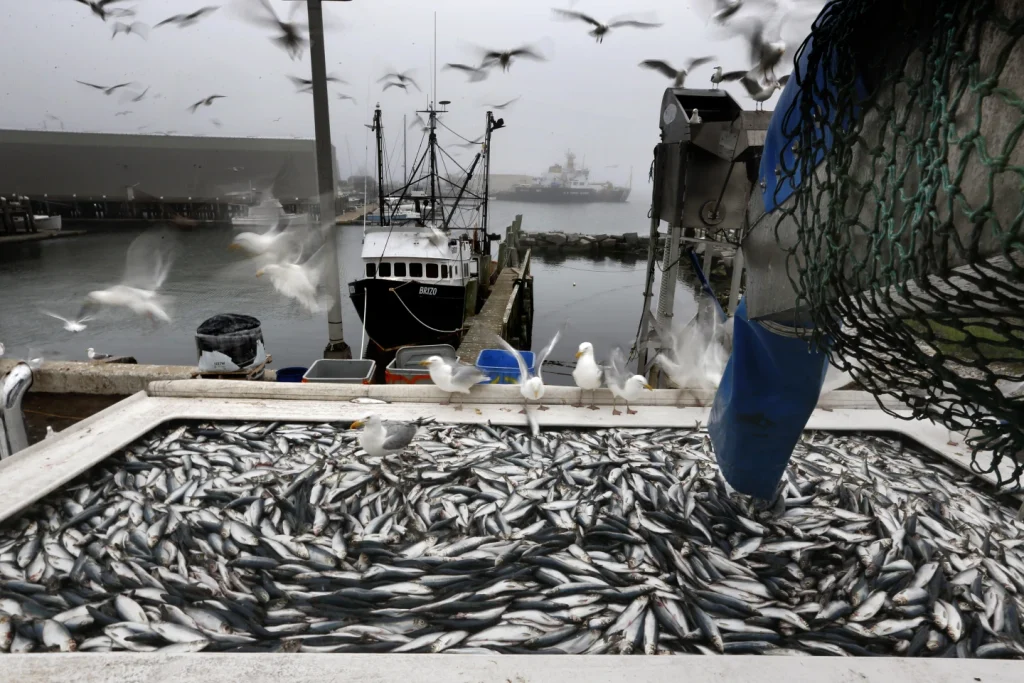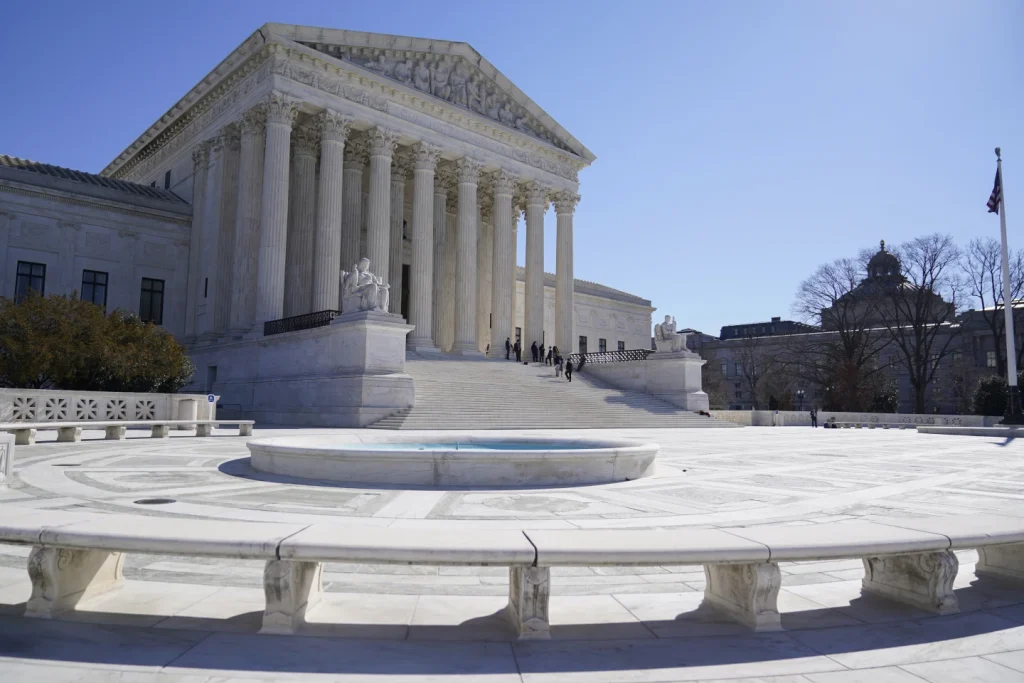The ongoing battle between business and conservative interest groups and federal regulators has reached a critical juncture with the case of Atlantic herring and the fishing boats that capture them.
This issue, which may not garner as much attention as cases related to former President Donald Trump, holds significant implications for government regulations across various domains such as the environment, workplace standards, consumer protections, and public health.
On the upcoming Wednesday, the Supreme Court will delve into the legal arguments presented by lawyers representing the fishermen, who seek to overturn a pivotal 40-year-old decision that has been frequently cited in support of regulatory power.
This decision has been used by lower courts to uphold a 2020 National Marine Fisheries Service rule, which mandates herring fishermen to bear the costs of employing monitors to track their fish intake.
A group of commercial fishermen has appealed this decision to the Supreme Court, underscoring the high stakes involved.
The financial implications of this case are substantial, with billions of dollars potentially hanging in the balance.
It is worth noting that the composition of the Supreme Court, much like the broader federal judiciary, has been reshaped during the tenure of former President Donald Trump, with conservative interests exerting influence to not only address social issues such as abortion but also to curtail the powers of the regulatory state.
Central to this legal battle is the 1984 decision in the case colloquially known as Chevron, which established that in instances where laws are not unequivocally clear, federal agencies should be granted the authority to fill in the details.
Advocates of limited government have long targeted this decision, arguing that it confers judicial powers to government experts, thereby undermining the role of the judiciary.
Mark Chenoweth, president of the New Civil Liberties Alliance, which is representing fishermen from Rhode Island, has articulated the concerns of those seeking to limit the reach of federal agencies.
He contends that deferring to the agency’s interpretation of the law effectively allows the agency to act as a judge in its own case.
The New Civil Liberties Alliance, backed by conservative donors including the Koch network, has made it their mission to reduce the size and influence of the administrative state.
The implications of the Supreme Court’s decision in this case extend far beyond the fishing industry.
It has the potential to reshape the balance of power between federal agencies and the judiciary, with far-reaching consequences for regulations that affect businesses, environmental protection, labor standards, consumer rights, and public health.
In conclusion, the legal battle over the Atlantic herring and the regulatory powers of federal agencies represents a critical juncture in the ongoing struggle between business interests, conservative groups, and federal regulators.
The outcome of this case has the potential to redefine the balance of power between government agencies and the judiciary, with significant implications for a wide array of regulations that impact various facets of society.
As the Supreme Court prepares to deliberate on this matter, the implications of its decision are poised to reverberate across the realms of governance, law, and public policy.
The ongoing debate surrounding the support for fishermen by various business and conservative interest groups, as well as the potential impact of the Supreme Court’s decision on federal agency powers, has sparked significant controversy and concern within the legal and environmental advocacy communities.
This complex and multifaceted issue has garnered attention from a wide array of stakeholders, each with their own perspectives and vested interests.
At the forefront of this debate are groups representing industries such as gun, e-cigarette, farm, timber, and home-building, all of which have thrown their support behind the fishermen.
Concurrently, conservative interests that have previously been involved in high court cases pertaining to environmental regulation have also aligned themselves with the fishermen’s cause.
This convergence of support from diverse business and conservative entities underscores the far-reaching implications of the issue at hand.
David Doniger, a senior lawyer for the Natural Resources Defense Council, has expressed apprehension regarding the underlying motivations of Chevron opponents, asserting that their true objective is to undermine the efficacy of modern government.
This sentiment reflects the deep-seated concerns regarding the potential ramifications of the Supreme Court’s decision on government functionality and regulatory oversight.
The uncertainty surrounding the court’s stance and the potential for either incremental or sweeping changes adds a layer of complexity to the situation, with Doniger emphasizing the potential threat to effective governance in the event of a radical shift.
Conversely, environmental and health advocacy groups have rallied in support of upholding the Chevron decision, emphasizing the critical importance of maintaining regulatory frameworks for the protection of public health and the environment.

The involvement of health care groups, including the American Cancer Society, in warning against the disruptive consequences of overturning Chevron underscores the broader societal implications at stake.
The composition of the Supreme Court, characterized by a conservative majority and the presence of three Trump appointees, has introduced a dynamic element to the debate.
The growing skepticism among justices regarding the authority of federal agencies, particularly evidenced by the questioning of the Chevron decision by Justices Clarence Thomas, Samuel Alito, Neil Gorsuch, and Brett Kavanaugh, has set the stage for a contentious legal battle with far-reaching implications.
The focal point of the public discourse surrounding this issue is the plight of the fishermen who rely on the waters off the East Coast for their livelihood.
The regulatory mandate requiring these fishermen to bear the financial burden of carrying monitors on their boats, with potential costs exceeding $700 per day, has become a focal point of contention and has galvanized support from various quarters.
In light of these developments, it is evident that the debate concerning the support for fishermen and the potential impact of the Supreme Court’s decision on federal agency powers transcends narrow industry interests and legal intricacies.
The broader implications for governance, environmental protection, and societal well-being underscore the gravity of the issue at hand.
As the stakeholders continue to advocate for their respective positions, the outcome of this legal battle will undoubtedly reverberate across multiple domains, shaping the landscape of regulatory oversight and governance in the United States.
The intricate relationship between regulatory authority, industry interests, and legal battles has once again come to the forefront with the ongoing case involving fishermen and the Chevron decision.
This legal saga, which has seen the Cause of Action Institute and a group of fishermen challenging federal regulations, sheds light on the complexities and implications of regulatory oversight within the fishing industry.
At the heart of this dispute lies the question of whether federal regulators have the authority to impose monitoring fees on fishermen, a matter that has generated significant debate and legal contention.
The Cause of Action Institute, an anti-regulatory group with ties to the Koch network, has strategically identified this issue as a means to challenge the Chevron decision.
According to Ryan Mulvey, a lawyer with the institute, the group saw an opportunity to contest the Chevron decision and subsequently recruited fishermen to sue.
The crux of the lawsuits revolved around the argument that Congress had not granted federal regulators the authority to mandate fishermen to bear the costs of monitors.
Despite their efforts, the fishermen faced defeat in the lower courts, where the Chevron decision was utilized to uphold the regulation.
However, the Supreme Court’s decision to hear the case signifies the gravity of the issue at hand. Notably, the court remained unconvinced by arguments asserting that no individual had been compelled to pay the fee or that the regulation had been formulated by regional councils inclusive of industry representatives.
The fishermen’s discontent with the presence of monitors was palpable, as highlighted by Leif Axelsson, the co-captain of the fishing boat Dyrsten, who likened the experience to having an unwelcome observer in one’s living space.
This sentiment reflects the broader apprehension among fishermen regarding the imposition of monitoring fees and the perceived intrusiveness of regulatory oversight.
The plight of the fishermen is further underscored by the challenges facing the industry itself. The decline in herring populations, as evidenced by a significant reduction in catch quotas, has had profound repercussions for fishermen, particularly those reliant on herring as bait.
The impact of overfishing has necessitated stringent government measures, leading to a substantial decrease in the allowable herring catch.
Consequently, fishermen have had to contend with dwindling resources and adapt to the changing dynamics of their trade.
The provision of government assistance underscores the severity of the situation and the need for measures to mitigate the adverse effects of overfishing on the industry.
The historical context of the Chevron decision adds another layer of significance to the ongoing legal battle.
The 1984 ruling, which favored an industry-friendly interpretation of an air pollution regulation, marked a decisive victory for environmental groups.
However, the subsequent evolution of judicial perspectives and the changing composition of the Supreme Court have led to a reevaluation of the Chevron decision.
The current justices’ inclination towards a more assertive judicial role contrasts with the limited approach advocated by Justice John Paul Stevens in the original ruling.
This shift in judicial philosophy has significant implications for the interpretation and application of regulatory authority, as evidenced by the continued reliance on Chevron in lower courts.
The impending decision in the ongoing cases holds profound implications for the fishing industry and the broader landscape of regulatory oversight.
The outcome of this legal battle will not only shape the regulatory framework governing fishermen but also have far-reaching implications for the interpretation of regulatory authority in the context of industry-specific regulations.
Paul Clement’s assertion that the Supreme Court should reconsider the continued reliance on Chevron underscores the urgency and significance of this issue.
The prospect of a decision by early summer heightens the anticipation surrounding this pivotal legal showdown.
In conclusion, the legal battle involving fishermen, regulatory authority, and the Chevron decision encapsulates the intricate interplay between industry interests, regulatory oversight, and judicial interpretation.

The implications of this case extend beyond the immediate concerns of the fishing industry, resonating with broader questions of regulatory authority and judicial discretion.
The outcome of this legal saga will undoubtedly shape the trajectory of regulatory oversight and industry compliance, underscoring the enduring relevance of this contentious issue in contemporary legal discourse.
